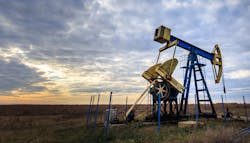Refracturing Revitalizes Old Oil Wells
Researchers at Los Alamos National Laboratory are combining extensive data mining and analysis of 20,000 shale gas wells with new technologies—including better fracturing techniques and innovative working fluids such as supercritical carbon dioxide—to transform oil and gas wells that would’ve been considered at the end of their productive lives a few years ago into high-performers.
“Our analysis could potentially aid in reducing the number of new wells to be drilled,” says Richard Middleton, leader of a team of Los Alamos National Laboratory scientists. “In addition, we see ways to both increase shale gas recovery and minimize environmental impacts through carbon sequestration.”
Their analysis, which reviewed 23 years of production from 20,000 wells, identified key discoveries, lessons learned, and recommendations for greatly improving “tail production,” that is, the long-term production after the initial peak production of a well.
Los Alamos applies its expertise in data analysis and high-performance computing to study oil and gas production as part of its mission to enhance the nation’s energy security.
“We hypothesize that manipulating tail production could re-revolutionize shale gas extraction,” says Middleton. Shale gas production through hydraulic fracturing is characterized by substantial gas production in the first few months to a year, but the production exponentially declines after only a month or two. Tail production starts about 12 months after this initial exponential decline. “Hydraulic fracturing research has largely focused on the initial 12-month production, since an operator will break even and make a profit from this ‘exponential’ production. However, we want to emphasize the importance and value of this long-term, tail production,” Middleton says.
The data mining analysis revealed that “refracturing” existing wells with new technology can transform them into high-performing wells with the production characteristics of a newly drilled site and this has profound implications in the potential revitalization of the hundreds of thousands of shale gas wells across the U. S.
Refracturing existing wells drastically reduces environmental impacts by using the existing footprint. Refracturing could also be particularly important because our research shows that older fracturing technologies leave behind a greater amount of shale gas resources than more modern techniques.
In addition, using existing wells for a longer period of time is cost-effective, the reserachers point out. Restimulating an existing well eliminates the capital cost of a new well, while providing a smaller environmental footprint.

